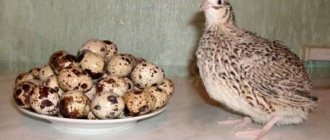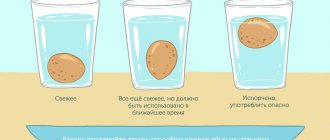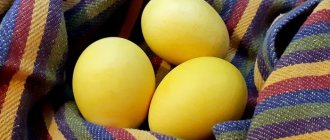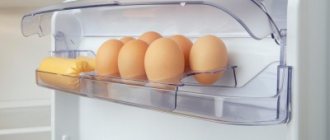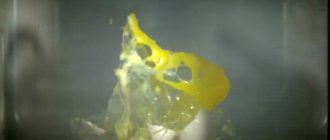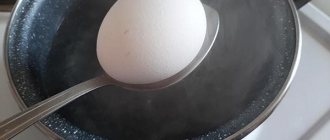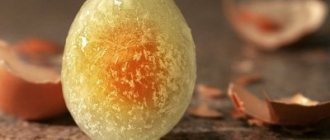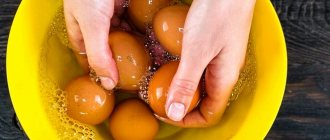We present to you ways to determine the freshness of quail eggs
Quail eggs, despite their miniature size, are a healthy dietary product. They differ from chicken not only in size and set of microelements, but also in their short shelf life. And due to less demand, they often sit on shelves for a long time. Everyone should know how to determine whether a quail egg is fresh or not. An expired product can cause harm to the body.
How to check the freshness of quail eggs
The quality of quail eggs can be determined as follows:
- Electronic balance. A recently laid quail egg weighs about 15-18 grams, that is, quite heavy for its size. An old egg is light, as if empty, and weighs about six grams on the scale.
- Container with water. The fresh ones will sink, the older ones will remain floating on the surface. This method is only suitable for those eggs that do not have any damage.
- Break the quail egg and carefully examine its contents. If the egg is good, the white and yolk are located next to each other and hold their shape. The yolk itself is round in shape. With less fresh eggs, they lose their viscosity, so they spill easily. This product should not be consumed, otherwise you may get poisoned.
The first seven days after laying, quail eggs are considered dietary, then they move into the table category. It is recommended to keep fresh eggs for three days before cooking. During this time they acquire amazing taste.
To protect yourself from trouble, be sure to wash all eggs thoroughly before cooking. If you are preparing any dish, first crack an egg into a cup to make sure there are no foreign odors or any impurities.
The product should be stored in the cold part of the refrigerator.
Look at the yolk and white
The method of external inspection of a raw egg, which needs to be beaten into a flat plate, is quite informative. A fresh egg's yolk has a round shape and holds it well.
The white is compactly held around the yolk. If the contents are mixed together, then the product has already expired. It is better to avoid using it.
There are several other signs that an egg is old:
- A flat yolk that breaks easily.
- Free floating yolk.
- Transparent, watery white. If the protein has a smoky tint, then this is a sign of freshness of the product.
How to check the freshness of quail eggs in water?
The most common and affordable way to make quail eggs is to use water. For this you will need a bowl and a wide glass.
A quail egg is a real storehouse of nutrients.
Sequencing:
- The container is half filled with cold, slightly salted water.
- The location of the testicles in the container is carefully studied. Quail eggs have an air chamber that increases in size over time. Accordingly, the higher the product is in a container with water, the more likely it is that the product is spoiled and the prepared food is hazardous to health.
Details of the location of the egg will help tell you about the degree of its freshness:
| Product Location | Freshness level |
| Sideways at the bottom of the container | Very fresh |
| At the bottom of the container, the end touches the bottom of the container | Packed a long time ago, but cooking is safe |
| Dropped to the middle of the tank | Medium fresh egg |
| Floats on the surface | The product is spoiled |
How to choose the right quail eggs in the store?
Unlike chickens, quails have better immunity and their eggs are less likely to be infected with anything (for example, salmonella), while quail eggs contain a high content of lysozyme - a substance that prevents the development of bacteria and microflora in the egg (by the way, this is why these eggs during long-term storage they do not go out, but dry out). Quail eggs are very healthy and nutritious, and will be useful in the diet for many buyers, so in order to choose fresh and high-quality quail eggs, you should know the following selection secrets:
- When choosing quail eggs, the first step is to carefully check and inspect the condition of the shell so that there is no damage (cracks, chips) on it, since, unlike the shell on chicken eggs, it is more fragile and can easily be damaged (in quail eggs with Damaged shells are highly likely to harbor pathogenic bacteria).
- When choosing quail eggs, before purchasing, be sure to check their expiration date, and also pay attention to storage conditions (in the refrigerator in the store, in direct sunlight at the market). The average shelf life of quail eggs is up to 30 days at room temperature, or up to 60 days in the refrigerator.
- The weight of a quail egg should be on average within 10-12 grams; if the egg weighs less than 10 grams, it means it is no longer fresh and has partially shrunk inside.
- The external surface of the quail egg must be clean (slight contamination is acceptable), in which case this is an indicator that the manufacturer monitors the quality of its products (but this does not affect the quality of the egg itself and its beneficial properties).
Storage rules
Boiled quail eggs can be stored at room temperature for no more than 10 hours.
There are certain storage rules that help preserve the product for a long period of time:
- Do not wash the product before storing it. This helps wash off the natural protective layer and shortens the shelf life of eggs.
- To save money, the container in which the product was purchased can be used. The sharp end of the testicle should point down.
- You can use the folk method as a container. The product is placed in a deep bowl with cold, lightly salted water at the rate of 5 g of salt per 1 liter of water.
- In the refrigerator, it is better to place the packaging on the shelf, but not on the door. Constant temperature fluctuations will shorten product shelf life as a result of product fogging.
- You should not place cheese, fish, garlic, or onions next to the eggs. These products have a distinct odor that will transfer to the eggs.
- The storage should not be damp. This contributes to the appearance of yeast and fungi on the surface of the shell, which can get inside.
- Twice a month you need to review inventory and remove damaged copies.
- Eggs that have been stored in the refrigerator and then left at room temperature for more than 2 hours should not be eaten . The resulting moisture can cause pathogens to enter.
Shelf life depends on storage conditions: place, temperature, container used:
| Storage conditions | Product shelf life (in days) |
| Fresh in the refrigerator (temperature from 0 to +8 degrees, humidity 60-80)% | up to 120 |
| Fresh at a temperature of +22…+24 degrees when opened | 30 |
| Fresh at a temperature of +22…+24 degrees in a closed tray | 60 |
| Hard-boiled in the refrigerator, without damaging the shell | 7 |
| Hard-boiled in the refrigerator, with damaged shells | 3 |
| Boiled at room temperature | 0,5 |
At the time of buying
When going shopping, pay attention to the following important points:
- The date of manufacture must be clearly written on the packaging and not blurred. If a product is placed in a refrigerator in a store, its shelf life is 60 days. If eggs are kept on the sales floor at room temperature, they are suitable for consumption for no more than a month.
- When buying at the market, you need to see if the testicles are in direct sunlight. Within one week, in conditions of extreme heat and scorching rays of the sun, the product will dry out. You risk bringing home an empty shell.
- The shell should be thoroughly inspected for cracks and damage. The presence of any mechanical damage can provoke the entry and subsequent proliferation of pathogenic bacteria.
- It is recommended to place one egg from the batch on a flat surface and unscrew it. The lower the speed, the fresher the product.
- Quail lays eggs weighing 8-12 grams. Check scales at any retail outlet will help you find out the weight of goods. If it is significantly smaller or larger, the testicles are damaged.
- When purchasing eggs, you need to look not at the color of the shell, but at its smoothness and cleanliness. A conscientious manufacturer will send a dirty product for sale.
Be sure to read:
Keeping quails: from choosing a breed, incubation to slaughter and sale at home
Checking with light
The shell should be carefully inspected for cracks or damage.
X-ray inspection can provide information about the degree of freshness.
Eggs are allowed to be eaten if:
- The yolk is not in the center. It is displaced and located close to the shell.
- The edges of the yolk are blurred, making it difficult to see anything.
- A formed embryo in any form is present.
- A bloody clot in the shape of a ring is visible.
- There are dark spots inside the product.
- The white has a pink tint.
- The color of the yolk is red-orange.
Home methods to determine suitability
There are several ways to ensure the freshness of products at home. They are suitable for both quail and chicken eggs.
We recommend: Where and how can you store apples for the winter?
To the light
Hold the egg up to the light coming from a lamp of 100 W or more and examine it. If you notice an air gap between the shell and the film underneath it, then the product is not entirely fresh. The permissible size of the puga (this is the name of this formation) is 9 mm and 4 mm (for chicken and quail eggs, respectively)
If the layer is larger than these indicators, they should not be used. Also pay attention to the presence of drops of blood. Point and mobile formations are harmless; they occur when the chicken’s oviduct is damaged
But if you see a blood ring, which is the circulatory system of a dead embryo, you cannot use the product.
The proliferation of microorganisms leads to the formation of dark spots. They can also be detected by candling the egg. The use of such products is permissible after heat treatment. But it’s better not to risk it and throw away these eggs. If you have an ultraviolet lamp at home, try it out. Enlighten the product and carefully examine the color of the contents. A fresh chicken and quail egg should have a rich red tint, while a spoiled one should have a lavender or gray hue.
We use water
The spoiled egg will rise to the top
To check using the following method, you will need a glass that needs to be filled with water to a level of at least 10 cm. A deep bowl will also work. Place the egg in the container and watch its position. If it sinks to the bottom, then the product is fresh, and if it floats, it is unsuitable for use.
A chicken egg with an expiration date will sink to the bottom at one end, and the other will be located on top. It must be consumed in the near future and only in boiled form or used for baking.
Visual inspection of contents
Break the egg onto a plate with a flat surface. You can safely consume a product with a convex round yolk and white that retains its shape. The spoiled egg begins to spread.
If the yolk has acquired a bright orange color, blood got into it during the formation stage. You should not refuse such eggs: after heat treatment they become safe. They are used to prepare pancakes, pancakes, and cutlets.
On the left is a fresh egg (thick white and convex yolk), and on the right is a stale egg (as it has no shape and spreads)
Alternative methods
Pay attention to the markings. If the eggs contain the date of its application, they belong to the dietary category, that is, they were laid no more than 7 days ago
The absence of this information indicates that the product is of the table type. These are eggs that have already been stored for 7–25 days.
Veterinary and Sanitary Expertise
All eggs supplied for food production and sale, whether in a store or on the market, are subject to a Veterinary and Sanitary Examination (Vetsanekspertiza).
Raw quail can be stored at room temperature for up to 30 days. Refrigerate for up to one month. And even after this, you have up to 7 days left to use them.
Knowing how to check the quality of a product, you can avoid wasting time, nerves and money. In addition, protect yourself and children from poisoning.
Thus, for one batch that has passed the inspection, a Quality Passport and a Veterinary Certificate are issued confirming the absence of infectious diseases of birds in the farm where they are produced.
Veterinary and sanitary examination of quail eggs is carried out to determine the quality of the product, confirm the safety of their use and the absence of infection with infectious diseases.
Specimens found to be defective due to technical indicators or from sick birds are assessed as unsuitable for sale and destroyed.
The inspection is carried out visually, as well as using an ovoscope. If there are suspicions about the quality of the product, the egg may be opened.
Specimens that have passed the inspection are stamped “Veterinary Inspection” or issued a special label.
Benefits of quail eggs
It’s not for nothing that small bird eggs are more expensive than chicken eggs. Their benefits for the body are enormous.
Vitamins A and B6 improve the functioning of the immune system and help the body fight viruses. The yolk contains a microelement that, when ingested, is converted into serotonin. The hormone strengthens the nervous system and reduces stress levels.
The special composition of the product helps cleanse blood vessels of various debris. Quail eggs help prevent stroke, heart attack and atherosclerosis.
Vitamin B12 increases the amount of hemoglobin in the blood
The product should be used to prevent anemia and improve blood composition.
Vitamin B3 stabilizes insulin production, which is especially important for people with diabetes. Eggs contain pyridoxine and chromium, which reduce blood glucose levels.
Quail eggs improve the functioning of the thyroid gland, which is important if there is a lack of iodine in the body.
Important antioxidant (vitamin A) fights free radicals
The latter often provoke the formation of malignant tumors. The protein contains lysozyme, which destroys tumor cells. Thanks to these properties, quail eggs are effective in preventing cancer.
Quail eggs have a special effect on the male body. Phosphorus in the composition has a positive effect on the prostate gland and increases libido. The product is used to prevent the development of prostate diseases. In Bulgaria, drinks are prepared based on quail eggs to improve potency.
The content of vitamins A, E, D is especially important for women's health. As a result of consuming quail eggs, the condition of the skin and hair improves
During pregnancy and preparation for it, you should pay special attention to the product. Eggs reduce toxicosis, improve milk and increase its quantity
Doctors claim that they reduce the likelihood of pregnancy failure in the early stages.
We recommend: How to properly store potatoes at home in an apartment in winter
Quail eggs contribute to the proper physical and intellectual development of the young body. A large amount of vitamins and microelements leads to improved memory and attention, strengthening the immune system. The product does not cause allergies, so it can be safely introduced into children's diets.
Older people should consume quail eggs to improve their overall health. The composition of the product is rich in vitamins that improve vision. Vitamin B is good for brain function, and vitamin D strengthens bones. Regular use of the product improves memory and reduces the likelihood of injury.
Ways to determine the freshness of eggs at home
We will not consider complex freshness determination experiments involving the use of ultraviolet light, temperature measurements, etc. After all, you can check the suitability of a product at home using simple methods.
How to tell if an egg is rotten or not in water
Instead of plain water, you can use a saline solution. To prepare it, dissolve one incomplete tablespoon in 500 ml of water, although the concentration here is not so important, since the “old” product will float even in clean water.
This is due to the fact that under the shell there is a shell consisting of two layers, which freely allows air, light and moisture to pass through one-sidedly. The membrane in the obtuse part of the testicle divides, forming an empty airy part (pugu). It is of great importance for the embryo, because through it the exchange of gases between the body and the external environment occurs. The longer the product “lives”, the larger the size of the puga.
At the same time, the shell allows not only the natural gas mixture to pass through itself. Bacteria, including those that cause rotting processes, freely penetrate through it. Before a hen lays an egg, it is considered sterile. But as soon as it is “born”, its contents become vulnerable to microorganisms. When putrefactive bacteria get inside, gases and an unpleasant “aroma” begin to be released. The specific smell of a rotten product is the smell of hydrogen sulfide, a gas that accumulates due to protein rotting. Gases that accumulate in a spoiled product have a lower density, so such an egg will certainly float in water.
Checking freshness using light
The contents can be viewed through a light source with a power of at least 100 W. The freshness of the product is determined by detecting the puga, as mentioned above, the puga is the air layer between the thin egg film and the shell. It is located at the blunt end of the product. If the product is fresh, then the puga is absent; it appears after some time as a result of the evaporation of moisture and compaction of the contents under the shell.
In a dietary product, the puga should not exceed 4 mm, in a table product – 8-9 mm. A dietary protein product must have a uniform and dense yolk. When candling an egg, the yolk should be placed in the center. In a table egg, a slight displacement is possible, but if the yolk is nailed to the shell, then there is only one conclusion - it is no longer fresh. Visibility of the embryo in any category is excluded.
Sometimes, when viewing a product in the light, you can see minor blood inclusions; they are acceptable even in fresh products, but under one condition, they must be small and point-like. If the blood droplets look like a ring, then such a product should be thrown away, since even heat treatment will not make such an egg suitable for consumption.
If the white is pinkish in color and the yolk is orange-red, this indicates that blood entered during its formation. The presence of dark spots indicates that microbes have begun to multiply under the shell.
External signs of a spoiled egg
- Take a close look at the surface of the shell. For fresh products it will be matte or slightly rough. Old eggs have a smooth and shiny shell with a bluish tint.
- The next step is to take the product in your hand and squeeze it a little so that you can feel slight vibrations inside, then shake it. A fresh product is always full inside, therefore, shaking will not allow you to feel any changes.
- If, when you shake it, you feel as if something is flopping and shimmering inside the egg, then you are holding a “chatterbox” in your hand that is unsuitable for use. However, this method does not provide a 100% guarantee of egg freshness; it only allows you to weed out the “chatterboxes”.
How to determine by yolk and white
If you bought eggs at the store, but when you came home you suspected they were unsuitable, then break one onto a plate. A fresh egg should have a fluffy and voluminous white, more like jelly, with a less dense layer on top. If the layers of white are almost indistinguishable and the yolk is flat, then this egg can no longer “boast” of its freshness, but it is suitable for eating.
Signs of staleness
The detection of at least one of the following signs indicates poor quality of the egg product:
- dents, breaks in the shell;
- heavy odor of hydrogen sulfide or mold;
- blackened outer shell;
- when examined in the light or with an ovoscope, the egg is completely opaque, several shadows are visible - red or black spots;
- the protein is transparent, has a pink or green tint;
- the ingredients are mixed.
Based on these signs, it is easy to determine that the product is unfit for consumption.
How to check the freshness of eggs at home?
At home, you can use a quick method that requires plain or salted water. The popularity of this method is due to the fact that you don’t have to break anything, and everything will remain safe and sound for further use. Let's list what is required to check eggs for freshness:
- A regular quarter liter glass of water filled with cold tap water,
- The product itself that needs to be tested is
- Information on how to check the freshness of eggs in water.
Having lowered the product into a container of water, it will fall to the bottom and acquire a horizontal position. Does this determine whether it is fresh or rotten? Worth remembering forever - fresh!
When checking, you wonder how this method determines whether an egg is spoiled? The fact is that its shell fits tightly to the membrane, and if the product is fresh, it is characterized by the absence of air inside.
Chicken egg expiration process
This happens due to the penetration of air through the pores of the shell, which facilitates the detachment of the membrane from it, thereby inflating the air sac. A similar process occurs gradually during storage. The shelf life of the product is significantly reduced by improper storage and high temperature, which causes the development of bacteria. If, when dipping an egg into salt water, it floats on the surface, you should take note that it has already spoiled.
This homemade method will also help you know the degree of freshness, providing an additional guide. This will let the housewife know whether the product is fresh or not, and where to put it.
How to determine the freshness of eggs?
In the first week of their existence, they are considered dietary and can be used in preparing dishes that require a shelf life. If the eggs take a horizontal position in the water, then there is no doubt about their freshness. This product can be used to prepare any dishes.
The period from a week can be determined by looking at the same vertical position. However, this time the blunt end floats to the surface a little, but the sharp end still touches the bottom. This period indicates that the product is only suitable for hard-boiling or making an omelet. If the period is two weeks, you should not expect scrambled eggs with an attractive appearance, because the white will lie flat on the pan, like a pancake.
Provided that the sharp end does not touch the bottom, remaining in the center with the blunt end on the surface, it is worth talking about a two-week shelf life. The egg is suitable for consumption and is hard-boiled in ten minutes. It can also be added to salads. But there is a plus in this state of affairs: cleaning will happen much faster and will not be difficult.
If checking eggs for freshness ends up in a fully horizontal position, this indicates they are spoiled. Their decomposition process has already begun, which indicates the impossibility of consuming this product as food.
Now the reader is aware of how to check an egg for freshness in water. To extend shelf life, it is recommended to avoid washing before putting the product in the refrigerator, and check for freshness right before use. After all, eggshells are covered with pores, which maintain their shelf life, so as soon as they come into contact with water, the protective shell is washed off. Air penetrates faster, enlarging the air sac, and the product spoils.
Check chicken eggs for freshness using water and light?
If you need to determine the degree of freshness of a product that is already at home, the easiest way to do this is with water. This is an affordable and reliable option that allows you to fairly accurately determine the lifespan of an egg. The approach is determined by the structure of the food component. Under the shell there is a two-layer shell that freely allows light, moisture and air to pass through, but only on one side. As a result, a puga is formed in one of the poles - a part filled with air. The older the egg, the larger the unique formation.
To conduct the experiment, simply fill a deep container with water (at least 10 cm) and lower the food product into it. The fresh product will remain at the bottom of the bowl. Chicken eggs that are more than a week old will come off the surface with a blunt end. If the sample floats to the surface of the water, then it is hopelessly rotten and is already at least a month old.
Besides this, there is another method to determine the freshness of an ingredient using puga. The experiment can be carried out not only at home, but also in the store itself. We select one sample and carefully examine it through a bright lamp with a power of at least 100 W.
You need to try to consider the presence of a film at the blunt end of the object. In a dietary ingredient, the gap should be no more than 4 mm; in a dining room, up to 8 mm is allowed. Chicken eggs that have a larger cavity are considered stale.
If you know what signs to look for when candling an egg, you can learn a lot of interesting things about the product:
- The yolk should be strictly in the center, only a slight shift is allowed. If the component is nailed to the shell or its edges are so blurred that it is difficult to determine anything, the product is spoiled.
- A fully formed embryo in any form is unacceptable.
- Pinpoint blood spots are acceptable. If the clot forms a ring, it is better to discard the ingredient. Even heat treatment will not improve its quality.
- The presence of dark spots is a sign of microbes entering the main chamber. Such chicken eggs most often cause food poisoning.
- Sometimes the white even appears pink in the light, while the yolk appears red-orange. These are the consequences of blood getting into the camera. There will be no harm from such a product, but there will be minimal benefit.
In addition, there are no less informative and reliable methods for determining the quality of eggs. True, their use is useful only when working with the component frequently, because in most cases the product will need to be compared with its optimal state.
Buoyancy check
The most reliable test for egg freshness is the salt water immersion test. If the egg sinks, it is definitely fresh. The longer an egg is stored, the more it dries out and becomes lighter. So if it floats in a salt solution, does not sink, but does not float to the top, this indicates that it, of course, is not the first freshness, but is quite suitable for food. If the egg joyfully surfaces, this is a sure sign of its absolute unsuitability for consumption.
Salts for this experiment are usually taken in less than a tablespoon, calculated for half a liter of water, but the concentration of the solution is not so important here, because a spoiled egg will float even in clean water.
The egg is an important, extremely diverse food product from a culinary point of view, since in addition to the egg dishes themselves, the components of the egg (yolk and white) are used in the preparation of many other dishes: for example, soups and sauces are seasoned with egg yolk, and whipped whites are often necessary for stabilization. , for example, soufflé. The nutritional and biological properties of eggs are due mainly to biologically valuable proteins - one egg covers 15% of a person’s daily protein requirement. In terms of nutritional content, the white and the yolk are significantly different from each other: the former consists mainly of water and about 11% protein, while the yolk is rich in protein-phosphorus compounds, fat, minerals and vitamins. Along with fat-soluble vitamins A, D and E, it contains calcium, phosphorus and iron. Protein contains water-soluble vitamins, sodium, potassium and chlorine. The nutrients in eggs can be absorbed by humans almost completely, namely up to 95%. And, nevertheless, you should not eat too many eggs (more than 3 eggs per day) due to the high cholesterol content in the yolk.
Proper storage has a decisive influence on the quality of eggs. Eggs are sensitive to the environment, as odors and bacteria can penetrate through their porous shells. They should always be stored at a cool temperature (8 to 10 C) and high humidity. It’s best to store it in a special compartment of the refrigerator, away from strong-smelling foods. Under such conditions, eggs in the shell are stored for 3-4 weeks. Broken eggs are stored for 2 days, the yolk covered with water is also 2 days, and the white is stored for up to 14 days.
Frozen egg mass, no matter what composition, is stored for about 4 months
How to determine the freshness of an egg?
It is almost impossible to determine by appearance whether an egg is fresh or not.
But there are simple ways to check:
.
— If you shake a fresh egg
, then it will not make any sounds - There is also a rule -
the older the egg, the more moisture has evaporated from it
through the porous shell.
Due to this, the air chamber increases and the egg becomes lighter. — Buoyancy test
.
If an egg in a glass with a 10% solution of table salt (10 g of salt per 100 ml of water) sinks to the bottom, then it is fresh. An egg that is about 7 days old has a larger air chamber. The egg rises with its blunt end up. If the egg is completely floating on the surface, then its air chamber is even larger; it may already be several months old. — Test by breaking an egg
.
A very fresh egg has a strong, well-convex yolk, with a beautiful round shape and is surrounded by two rings of white: an inner compact one and an outer thinner one. - Boiling eggs.
The easiest way to cook eggs is boiling them in their shells. It may be recommended to lightly prick the blunt end of the egg with a thin needle to remove any air. Then the shell will not crack during cooking. If you need to hard-boil several eggs, it is better to put them in boiling water in a sieve. The cooking time is counted from the moment the water boils again. But this can only serve as a guideline, since the cooking time depends on the location - the higher above sea level, the longer the process of boiling the eggs takes, as well as on the temperature of the eggs before they were placed in boiling water. Although you don't need to cook them for too long, otherwise the protein will release hydrogen sulfide, and then the eggs will smell unpleasant. After boiling, it is recommended to rinse the eggs well with cold water to make them easier to peel.
Cooking time: 4-5 minutes
: the white is solid only on the outside, the yolk is still runny and dark yellow.
5-6 minutes
: the white is solid, the yolk inside is still liquid, the outer edge has already hardened a little.
6-8 minutes
: all the white is firm, the yolk is a little soft in the middle, the rest is soft.
7-9 minutes
: white and yolk are firm;
The yolk in the middle is slightly creamy and its color becomes lighter. 10-12 minutes
: the white and yolk can be cut, the yolk is already pale in color.
15 minutes
: The yolk loses its color even more, becomes dry and crumbles when cut.
Bon appetit!
